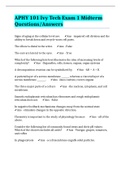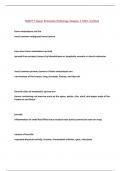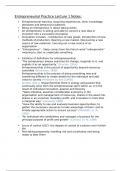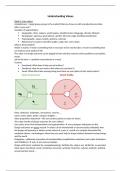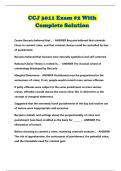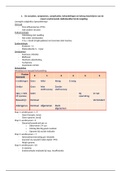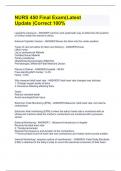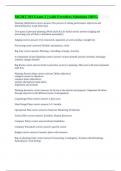Microeconomics – Term 1 Revision
Contents
I.1: Games in Strategic Form...........................................................................3
Pure Strategies.........................................................................................3
Mixed Strategies........................................................................................3
Strict Dominance.......................................................................................4
Weak Dominance.......................................................................................4
Nash Equilibrium.......................................................................................4
I.2: Games in Extensive Form...........................................................................4
Extensive Form.........................................................................................4
Perfect Information Games in Extensive Form (Trees and Strategies).....................5
Incomplete Information Games in Extensive Form (Information Sets).....................7
Nash Equilibrium (Non-Credible Threats)..........................................................8
Backwards Induction (Entry Deterrence and FDI).................................................9
Twice-repeated extensive form games.............................................................9
Subgame Perfection....................................................................................9
Hawk-Dove Game..................................................................................10
I.3:.........................................................................................................11
Cournot Nash Equilibrium (– Optimum Quantity in Oligopoly).................................11
Reaction Functions.................................................................................11
Dynamic Oligopoly....................................................................................11
Stackelberg Equilibrium – Quantity Leadership...............................................11
Price Leadership...................................................................................12
Cooperation through repeated interaction....................................................12
Bertrand Price Competition.........................................................................13
I.4: Production Functions..............................................................................13
Production Functions.................................................................................13
Production Sets.....................................................................................13
Production Functions..............................................................................14
Properties of Production Functions.............................................................14
Input Requirement Sets...........................................................................14
Marginal Rates of Transformation (MRT)......................................................14
Marginal Product (MP):...........................................................................15
Marginal Rate of Technical Substitution (MRTS):............................................15
Convexity of input requirement sets...........................................................16
, Homotheticity......................................................................................16
Homogeneity – Returns to Scale.................................................................17
Returns to Scale....................................................................................17
Examples............................................................................................17
Profit Maximisation..................................................................................20
Marginal Conditions and Input Demands/Supply.............................................20
Properties of the Input Demand and Supply Functions......................................21
Profit Function.....................................................................................22
Envelope Theorem and Hotelling’s Lemma....................................................23
Profit Maximisation – the general case:.......................................................24
Cost Minimisation.....................................................................................25
Minimisation problem.............................................................................25
Properties of Conditional Input Demands.....................................................25
Cost Function.......................................................................................26
Marginal and average costs......................................................................27
Profit maximisation, again.......................................................................28
Some examples, again.............................................................................28
I.5: Adverse Selection..................................................................................30
Adverse Selection.....................................................................................30
Market for Used Cars (”Lemons”) – Perfectly Competitive.................................30
Insurance Markets and Mathematical Applicability...........................................32
Number of customers given distribution of customers (uniform distribution)...........32
Expected Utility....................................................................................33
Market Failure and Asymmetric Information – Firms Can’t Tell Customers Apart.......33
Customer types and how to find the conditions for these..................................34
Equilibrium price in the market.................................................................35
Two-part Tariffs in a Simple Monopoly Setting..................................................37
How should the monopolist set p and the fixed fee F to maximize profit?...............38
Screening - Price setting for different customer types......................................39
1.6: Moral Hazard (all about actions)................................................................39
Principle-Agent Relationships.......................................................................39
Incentive Schemes....................................................................................39
Choosing wages and effort..........................................................................40
Labour Contracting Model........................................................................40
I.7: Designing Economic Systems......................................................................45
Mechanism Design Problem – Myerson-Satterthwaite...........................................45
Mechanisms and the Revelation Principle........................................................48
, The Beginning – Term 1
I.1: Games in Strategic Form
Pure Strategies
1. Pure strategies: all the actions/strategies available to player i.
o A typical action is si ∈ Si , where si= particular action.
2. Action profile: a list of actions for all the players in the game.
o The action everyone has taken in the game – a complete description of
what everybody in the game is doing.
3. Payoffs (Utility/Profit)
o Utility/profit for each player’s action profile (pure strategies).
o Profits of firm i:
Perfect Competition: NOT a strategic form game (because price is fixed).
o Solution: randomise players’ actions Mixed strategies.
How to find number of pure strategies?
o Number of options the player has available to them at each stage multiplied
together. Combination Rule.
Mixed Strategies
To find MS NE:
1. Set probabilities for the column (e.g. q, 1-q) and row players (e.g. p, 1-p).
2. Find the expected payoff for the row player given the column player’s
probabilities (so in terms of q).
3. Find the expected payoff for the column player given the row player’s
probabilities (so in terms of p).
4. Set each pair of payoffs equal to each other and solve for the probabilities p and
q.
5. E.g. if (½ , ½), the column player playing with probability (½ , ½) is a NE.
When the probabilities are given:
1. Work out the expected payoffs for the column player.
a. Check that they are equal.
2. Work out the expected payoffs for the row player.
a. Check that they are equal.
b. If they are equal, it is a NE.
, Strict Dominance
Weak Dominance
Nash Equilibrium
At an NE = each player’s strategy is a best response (fixed) to the other players’
strategies.
I.2: Games in Extensive Form
Extensive Form
A game in extensive form captures information about the order of moves (which is
ignored in the strategic form model).
Contents
I.1: Games in Strategic Form...........................................................................3
Pure Strategies.........................................................................................3
Mixed Strategies........................................................................................3
Strict Dominance.......................................................................................4
Weak Dominance.......................................................................................4
Nash Equilibrium.......................................................................................4
I.2: Games in Extensive Form...........................................................................4
Extensive Form.........................................................................................4
Perfect Information Games in Extensive Form (Trees and Strategies).....................5
Incomplete Information Games in Extensive Form (Information Sets).....................7
Nash Equilibrium (Non-Credible Threats)..........................................................8
Backwards Induction (Entry Deterrence and FDI).................................................9
Twice-repeated extensive form games.............................................................9
Subgame Perfection....................................................................................9
Hawk-Dove Game..................................................................................10
I.3:.........................................................................................................11
Cournot Nash Equilibrium (– Optimum Quantity in Oligopoly).................................11
Reaction Functions.................................................................................11
Dynamic Oligopoly....................................................................................11
Stackelberg Equilibrium – Quantity Leadership...............................................11
Price Leadership...................................................................................12
Cooperation through repeated interaction....................................................12
Bertrand Price Competition.........................................................................13
I.4: Production Functions..............................................................................13
Production Functions.................................................................................13
Production Sets.....................................................................................13
Production Functions..............................................................................14
Properties of Production Functions.............................................................14
Input Requirement Sets...........................................................................14
Marginal Rates of Transformation (MRT)......................................................14
Marginal Product (MP):...........................................................................15
Marginal Rate of Technical Substitution (MRTS):............................................15
Convexity of input requirement sets...........................................................16
, Homotheticity......................................................................................16
Homogeneity – Returns to Scale.................................................................17
Returns to Scale....................................................................................17
Examples............................................................................................17
Profit Maximisation..................................................................................20
Marginal Conditions and Input Demands/Supply.............................................20
Properties of the Input Demand and Supply Functions......................................21
Profit Function.....................................................................................22
Envelope Theorem and Hotelling’s Lemma....................................................23
Profit Maximisation – the general case:.......................................................24
Cost Minimisation.....................................................................................25
Minimisation problem.............................................................................25
Properties of Conditional Input Demands.....................................................25
Cost Function.......................................................................................26
Marginal and average costs......................................................................27
Profit maximisation, again.......................................................................28
Some examples, again.............................................................................28
I.5: Adverse Selection..................................................................................30
Adverse Selection.....................................................................................30
Market for Used Cars (”Lemons”) – Perfectly Competitive.................................30
Insurance Markets and Mathematical Applicability...........................................32
Number of customers given distribution of customers (uniform distribution)...........32
Expected Utility....................................................................................33
Market Failure and Asymmetric Information – Firms Can’t Tell Customers Apart.......33
Customer types and how to find the conditions for these..................................34
Equilibrium price in the market.................................................................35
Two-part Tariffs in a Simple Monopoly Setting..................................................37
How should the monopolist set p and the fixed fee F to maximize profit?...............38
Screening - Price setting for different customer types......................................39
1.6: Moral Hazard (all about actions)................................................................39
Principle-Agent Relationships.......................................................................39
Incentive Schemes....................................................................................39
Choosing wages and effort..........................................................................40
Labour Contracting Model........................................................................40
I.7: Designing Economic Systems......................................................................45
Mechanism Design Problem – Myerson-Satterthwaite...........................................45
Mechanisms and the Revelation Principle........................................................48
, The Beginning – Term 1
I.1: Games in Strategic Form
Pure Strategies
1. Pure strategies: all the actions/strategies available to player i.
o A typical action is si ∈ Si , where si= particular action.
2. Action profile: a list of actions for all the players in the game.
o The action everyone has taken in the game – a complete description of
what everybody in the game is doing.
3. Payoffs (Utility/Profit)
o Utility/profit for each player’s action profile (pure strategies).
o Profits of firm i:
Perfect Competition: NOT a strategic form game (because price is fixed).
o Solution: randomise players’ actions Mixed strategies.
How to find number of pure strategies?
o Number of options the player has available to them at each stage multiplied
together. Combination Rule.
Mixed Strategies
To find MS NE:
1. Set probabilities for the column (e.g. q, 1-q) and row players (e.g. p, 1-p).
2. Find the expected payoff for the row player given the column player’s
probabilities (so in terms of q).
3. Find the expected payoff for the column player given the row player’s
probabilities (so in terms of p).
4. Set each pair of payoffs equal to each other and solve for the probabilities p and
q.
5. E.g. if (½ , ½), the column player playing with probability (½ , ½) is a NE.
When the probabilities are given:
1. Work out the expected payoffs for the column player.
a. Check that they are equal.
2. Work out the expected payoffs for the row player.
a. Check that they are equal.
b. If they are equal, it is a NE.
, Strict Dominance
Weak Dominance
Nash Equilibrium
At an NE = each player’s strategy is a best response (fixed) to the other players’
strategies.
I.2: Games in Extensive Form
Extensive Form
A game in extensive form captures information about the order of moves (which is
ignored in the strategic form model).


